Menus
- Compromise without compromise
- 4 cylinders of 1,043 cm3, 142 hp and 111 Nm, 235 kg, from 14,349 euros
- Discovery
- In the saddle
- In the city
- Motorway and expressways
- Departmental
- Part-cycle
- Braking
- Comfort / Duo
- Consumption
- The little extra
- Video test
- Conclusion
- Test equipment
- Colors / price
- Standard equipment
Compromise without compromise
4 cylinders of 1,043 cm3, 142 hp and 111 Nm, 235 kg, from 14,349 euros
In 2010, Kawasaki presented its first Z1000SX, a road version of its Z 1000 reference roadster. A versatile machine, which has become the queen of the sport-GT segment, the Akashi reference saw a first evolution in 2014 with a more luggage mounting system. elegant, better quality suspensions and braking. The 2016 vintage optimized the sport-comfort compromise, reinforcing the appearance and sporting potential as much as the comfort of the crew. It was especially equipped with a multi-axial inertial unit boosting developments and safety.
In 2020, the Z1000 becomes Ninja 1000 SX and takes the opportunity to upgrade its electronics and comfort. What is needed in the sports tourism segment? Trial on 300 km of charming and varied Andalusian roads. Adelante !
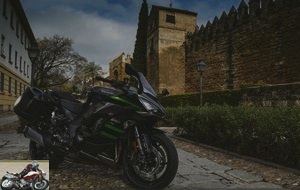 Kawasaki Ninja 1000 SX review
Kawasaki Ninja 1000 SX review
Discovery
Fourth evolution of the SX model, the Ninja 1000 SX is now ready for Euro5 (but not yet approved) and wants to strengthen its road capabilities, which is reflected aesthetically. Its rear half thus evokes travel and duo, especially with luggage when the front suggests sport and its track cousin ZX-10R.
 Former Z, the 1000 SX becomes Ninja for 2020
Former Z, the 1000 SX becomes Ninja for 2020
The fully LED lights combine vertical faces and flat flats, embedded in the sharp angles of the fork crown. Its sharp volumes now curve behind the headlights, for more protection. Still adjustable by pressing a button under the dashboard, the screen now switches to four positions. Its shape changes significantly in the upper part, more elegant and complex.
 The lighting of the Ninja SX is LED
The lighting of the Ninja SX is LED
Laterally, the Ninja 1000 SX evolves slightly, streamlining its lines with new fairing elements. Very discreet, subtly integrated scoops, two-tone trim and front indicators barely protruding from the surfaces. The sides are then elegantly indented around the engine. Much more harmonious and better dissipating the calories of the mechanics, this set encloses the triangular volume, with prominent shoulders, of the 19-liter tank. It is supported by a thicker and wider rider’s seat, surmounted by a more comfortable, longer and much more ergonomic passenger seat. The accompanying handles, pleasantly curved, are accompanied by the plates integrating the suitcase supports. Stylish, the trunks are optional. Fully sheathed, the stern ends with a LED light and rests on a rear loop made of three pieces of die-cast aluminum.
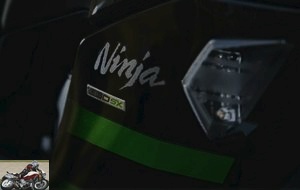 The new skin reveals smoother lines
The new skin reveals smoother lines
The assembly rests on a double aluminum beam frame passing above the engine with load-bearing function, which makes it possible to narrow the machine. Five die-cast aluminum parts (steering column, left and right main pillars and two transverse joints) are attached to the engine by four brackets.
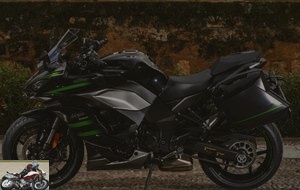 The SX still sits on a double-beam aluminum frame
The SX still sits on a double-beam aluminum frame
The 1,043 cm3 (77 x 56 mm) four-cylinder with dual ACT and 16 valves evolves a bit to anticipate Euro5. Camshaft profiles, intake ducts 45 mm shorter for cylinders 1 and 4, revised mapping and 3-way catalyst in the manifold make it possible to pass the standard. The mechanics benefit from a double butterfly injection (with ovalized secondary ducts) which allows the engine to deliver torque at low and mid-speed. The use of these secondary elements, controlled by a computer, artificially reduces the passage section of the mixture, in order to optimize the filling of the cylinders whatever the engine speed. The block still delivers 142 hp at 10,000 rpm and 11.1 da.Nm of torque, but now at 8,000 revolutions per minute (+700). To see in dynamics. A secondary balance shaft limits vibrations.
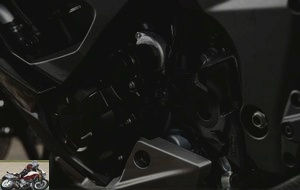 The 4 cylinder engine is ready for Euro 5, but not yet approved as such
The 4 cylinder engine is ready for Euro 5, but not yet approved as such
New, the Ninja 1000 SX’s throttle grip is of the ride by wire type. Thus the chip intelligence controls four engine modes (Sport, Road, Rain and Rider (customizable). They control the electronic assembly associated with the inertial unit (IMU) with 3 axes and 6 directions. Thus, anti-skidding (KTRC ) and ABS on the angle (KIBS) always more effectively make up Akashi’s trajectory control the KCMF …. By its predictive work, this system helps to more easily register the machine in the targeted trajectory, throughout the turn. Indeed, the system does not wait for slipping or blocking, but anticipates the problems by the movement of the vehicle. These assistances are modulated by the selected profiles. Permissive in Sport, they will regulate more in Road. In Rain mode, the power is limited to 75% (106 hp). The Rider mode allows you to manage as you see fit or even deactivate the traction control. Finally, the traveler is also equipped with a cruise control! we have been waiting for a long time.
 The Ride-by-Wire accelerator comes with 4 riding modes
The Ride-by-Wire accelerator comes with 4 riding modes
Another appreciable equipment, a quickshifter (KQS) allows you to up AND down gears as on the most sporty of motorcycles. In addition, the clutch is assisted and anti-dribble. The "Assist & Slipper" technology uses two types of cams (a locking cam and a slip cam) to compress or separate the pressure plates from the clutch housing. The first relieves the clutch spring, softening In the event of excessive engine braking (downshifting too fast), the sliding cam then kicks in. It disengages the pressure plates from the clutch housing. This relieves the force exerted on the clutch discs , limiting rebounds as well as locking the rear wheel.
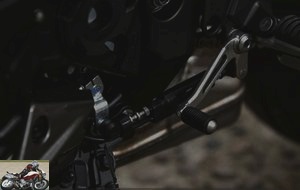 The KQS quicksifter works in upshifts and downshifts
The KQS quicksifter works in upshifts and downshifts
All this equipment is based on a quality part cycle, with ribs promoting dynamic and lively behavior. Thus, the column angle is 24.5 ° and the wheelbase contained with 1,440 mm. There is also an inverted fork of 41 mm fully adjustable by progressive system. In cast aluminum, the swingarm is entrusted to the care of a Kayaba shock absorber whose stroke lengthens by 6 mm (144mm), adjustable in rebound and preload. The latter is modulated via a qualitative wheel offset on the right passenger footrest plate. The horizontal positioning, Back-link type of this suspension frees up the space otherwise occupied by the lower link. This configuration optimizes mass centralization, placing the catalyst under the machine. A positioning which however prohibits, since the origin of this model, the possibility of placing a central stand. A single exhaust now adorns the right side of the machine. Not very attractive, taken from that of the Versys, it disappoints a little ….
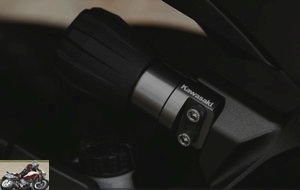 The KYB rear shock absorber is adjustable in preload and rebound
The KYB rear shock absorber is adjustable in preload and rebound
The 6-spoke aluminum rims fit Bridgestone Battlax S22 tires designed for this model, in 120/70 and 190/50. To stop their momentum, two Tokico monobloc calipers with 4 opposed pistons and radial mounting, like the master cylinder, attack discs with petal frets of 300 mm. The opposing single piston retarder grips a 250mm disc. Smart ABS (KIBS) is standard, but elbow valves are not.
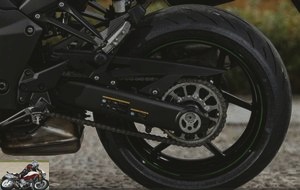 The SX puts on Bridgestone Battlax S22 tires
The SX puts on Bridgestone Battlax S22 tires
Construction, quality of components and finishes are of a high standard, giving the Ninja 1000SX an image of high-end road. Although not very visible, the engine block takes care of its appearance on all its faces and limits unsightly peripherals. Hoses and cables are well integrated, metal and plastic surfaces enhance the aesthetics of the Kawasaki.
In the saddle
An immediately noticeable development of importance takes place aboard the Road Ninja. The seat increases to 835 mm (+ 20), but it is above all the seating comfort that we will remember. With its thicker foams, the profile studied, the passenger seat also greatly increases its level. Don’t worry, you can ask for a low (820mm) or very low (812mm) saddle. The standard element places the rider slightly more forward. Too bad, the recoil available is not yet perfect for the older ones. The bust therefore tilts with just the right amount of sportiness on the half-handlebars. Slightly inclined and fairly open, these enhanced elements combine with a very well-made triple tree. They support quality and ergonomic controls. Different rockers control the electronic functions with good ergonomics.
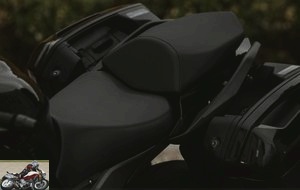 Thicker saddle foams increase the seat height to 835 mm
Thicker saddle foams increase the seat height to 835 mm
In front of you, a brand new 4.3-inch color TFT screen (as on the Z900) with automatically adaptable brightness, now displays gear engaged, engine mode selected and a bargraph tachometer dominating the tachometer, fuel and temperature gauge engine, clock and, by successive pressure on the left-hand stalk switch, partial, odometer, average and instantaneous consumption, maximum angle grip, range, average speed and battery charge. The motor modes are controlled in the same way. The display offers two styles, not very different. One, more sporty, limits the amount of information and provides graphical information on the level of braking or acceleration and the displacement of the motorcycle’s attitude…. The other, standard, is more pleasant and rational. Both can be read on a dark or white background, the latter is more pleasant and ideal for avoiding reflections.
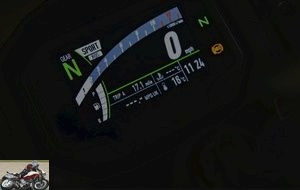 4.3 inch color TFT instrumentation is identical to that of the Z900
4.3 inch color TFT instrumentation is identical to that of the Z900
The instruments also offer extensive functionality. In detail using the smartphone app "RIDEOLOGY THE APP", information such as fuel gauge, odometer, maintenance schedule, etc. can be viewed on smartphone. The Riding Log functionality displays the route and engine speed there. Connected via Bluetooth, you will even receive your emails or texts…. When "the essential" competes with "the essential". Finally, the general parameters of the instrumentation (distances, date, etc.) can be set via the smartphone. More useful, this quality equipment records your GPS routes.
 Like all new Kawasaki, the Ninja 1000 SX connects via the Rideology app
Like all new Kawasaki, the Ninja 1000 SX connects via the Rideology app
Everything takes place in a neat cockpit overlooking a fork then just as well finished. The only remark is that the positioning of the instrument unit follows the plunging line of the machine, projecting it a little deeply and far from the eyes. Finally, the clutch lever is adjustable in spacing in 5 positions, that of the brake in 7 increments.
In the city
The big four-cylinder Kawasaki is an athlete. Barely awake, his ample voice sets the tone from the warm-up, blowing his usual melody of bass and then more metallic trills. Kawasaki always takes care of the work on the airbox and the exhaust, showing a character in keeping with the sporty personality that characterizes this machine. Its LED front lights always make up a powerful light signature.
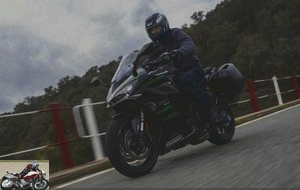 The electronic accelerator is very precise
The electronic accelerator is very precise
Obvious to the grip, Akashi’s marathon runner navigates traffic with ease. The balance of its masses is one of its greatest qualities. The flexibility of its mechanics is another, allowing to evolve smoothly on the last report. Ever more precise, the electronic throttle grip ensures perfect control of the injection. Even approval for its assisted clutch which is sometimes used a little in town. The lever would operate without thinking about it because it is so flexible, but the excellent quickshifter puts it in forced rest. A kind of shock absorber placed on the latter barely moves the boot to change gear. The system works flawlessly.
Without a suitcase, the Ninja 1000 SX copes with everyday urban life with skill. Low, it allows good control on all occasions. Only the U-turns admit a perfectible turning radius.
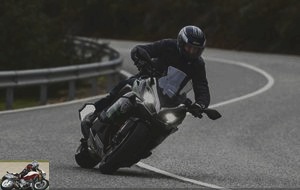 Quickshifter and flexible lever provide real comfort in town for gear changes
Quickshifter and flexible lever provide real comfort in town for gear changes
Vibration-free and wide, the mirrors provide an excellent field of vision. Although of medium width, the suitcases protrude a little from the width of the mirrors. Not forgetting these useful appendages can avoid many setbacks. Particularly discreet in the city, the tourist Ninja gets along there to hide her true identity. Mistrust…. because his warrior soul is never far, ready to cut the horizon.
Motorway and expressways
Akashi’s four-cylinder are among the most demonstrative of their kind. The genes from the (distant – ZX9R) sporting origins of the Ninja 1000 SX boiler remain present, in perfect harmony with the spirit of the sport-GT. Beyond 6,000 laps, in Road or Sport mode, acceleration is sustained on the intermediates, the three leading to more than 170 km / h towards the red zone. The screen then flashes, acting as a shiftlight. These acceleration on the driveways cause traditional vibrations to appear in the saddle and in the handles. However, nothing distressing, because these waves are only felt at these precise times. Sensitive between 6 and 7,000 turns, they return to a normal dimension outside this range.
 The 4-cylinder engine can exceed 240 km / h in the last gear
The 4-cylinder engine can exceed 240 km / h in the last gear
Capable of more than 240 km / h on the last report, the Kawasaki would allow fast and comfortable trips at speeds barely less legal. Indeed, to hold a good 150 of average is a formality on board, the four-cylinder admitting then barely more than 6,000 revolutions. The legal is 500 revolutions lower, also reducing consumption from half a liter to 100. With the bubble raised, the protection is very acceptable, clearly relieving the neck and chest. The flow reaches the top of the helmet, the shoulders take in the air, but the legs are well protected. No turbulence disturbs the crew. Always this subtle balance between two universes. Finally, the handling with both suitcases is impeccable, whatever the pace …. And with cruise control, with "summarize" – resume function, the motorway would be almost less of a bleed. But staying there longer would be wasting the dynamic potential of your mount. Tourism is done by winding roads; for sport, it’s up to you ….
Departmental
It’s all about choice. But with so much potential between the legs, it’s hard not to take action. Especially when it’s available to you. The road. And the organization found a Garden of Eden for us to gather many forbidden fruits. Alternating full and loose, it will allow the road Ninja to draw its most beautiful letters, composing a seductive odyssey.
 Akashi’s 4-cylinder delivers 142 hp and 111 Nm
Akashi’s 4-cylinder delivers 142 hp and 111 Nm
On the corner we appreciate the precision of the new accelerator which allows you to stay on a trickle of gas. The injection control is very precise. Ditto on the raises at the exit of the curve where the anti-skating joins the waltz of the learned chips. We sometimes see the KTRC witness light up when the 111Nm of torque torments the Battlax S22s. But these envelopes provide excellent grip and very good bitumen feel. A more road ride may be preferable in the rain. With these Bridgestones, the low temperatures and a little humidity in the morning put the electronics to work. The latter is always almost transparent in its implementation, whatever its nature. Road mode provides additional safety (KTRC 2 – ABS 2) while Sport mode heals pure efficiency (KTRC 1, ABS 1). The latter is ideal for fully benefiting from the exuberance of the machine, little miserly primer of wheeling. These can be performed while remaining in this mode, the electronics not detecting any particular concerns.
It is in the winding that the Japanese traveler reveals herself. Casting like Don Quixote on the windmills, the SX throws itself at a good pace on the Iberian corners, putting Akashi’s KCMF system to the test. Engaging the brakes reveals powerful front calipers that are perfectly manageable with the grip. Therefore, the inertial unit will optimize the evolution of the machine. Its movements inform artificial intelligence about the multi-axis position of the motorcycle. During the strongest decelerations, you can feel the electronics regulating the pressure of the clamps and the possible action of the ABS. When the rear sheds or rises sharply under the attack of the Tokico calipers, the machine moves, but stays in line and probably avoids a good sweat, or worse.
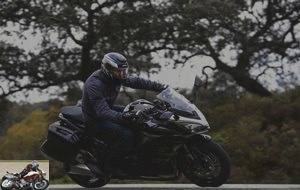 The Ninja 1000 SX is equipped with Tokico front brake calipers
The Ninja 1000 SX is equipped with Tokico front brake calipers
The carefully adjusted suspensions also give the best of sport and touring. Depending on your preferences, you will adapt them to your liking. The fork travel is remarkably slowed down from the start of sinking. Its progressive springs are a real quality. The rear trigger could be braked more, limiting a little the lift of the wheel already mentioned.
Addictive, this safety allows you to drive hard and lets the crew spring to the next turn. The Road Ninja leaps through switchbacks, with no downtime or inertia. The agility of the 1000 SX is a real treat, proving the most successful weight distribution. In addition, the riding position is ideal, leaving just the right amount of pressure on its half-handlebars when opened. Akashi’s sport-GT looks a bit like road racing, sporty machines equipped with a straight handlebar. This similarity of approach makes the Kawasaki highly efficient on the road. At a very engaged pace, control of the front axle is thus excellent and the Kawa easily allows course corrections. With the saddle allowing easy movement and good support on the footrests, you can take a rhythmic angle grip. Because its four-cylinder gives the envy of its evolutions. If the sound signature of the mono-escapement is a little less suave, the airbox makes its powerful breath heard when the 142 horses of its stud break. Full at any speed on the intermediate reports, the Japanese block changes behavior beyond 6,000 rpm, then reinforcing its thrust with each graduation of the tachometer. It pulls fat out of a corner on the corner. No problem with the peak torque offset, the exploitable curve is only wider. Moreover, in tight evolution, the vigor of the engine demands attention as the Ninja 10000 SX reduces the space.
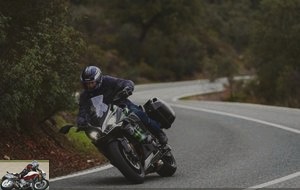 KTRC traction control and ABS on the KIBS angle assist the pilot in controlling his trajectories
KTRC traction control and ABS on the KIBS angle assist the pilot in controlling his trajectories
On a more curled pace or with a passenger, the rain mode will be welcome. He will keep the crew in serene comfort. On higher gears, the Ninja is GT, then walking his world through landscapes. Absorbing all the defects of the bitumen with equal efficiency, the Ninja 1000 SX still composes one of the best behaviors and equipment at this level of the range. And, always available, the Japanese block coats its raw strength with an unusual softness..
Part-cycle
With one of the best suspensions in the segment, the Ninja 1000 SX is unperturbed. On the angle, it keeps its course whatever the coating and its rigid chassis makes it a corner chaser. Adjusted, shock absorber and fork can make it even more incisive.
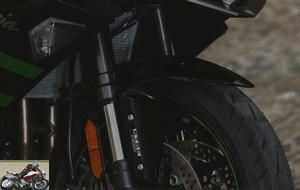 The inverted fork of the Kawasaki Ninja 1000 SX
The inverted fork of the Kawasaki Ninja 1000 SX
Braking
Very powerful, the front calipers are no joke with safety and sportiness. They barely stiffen the steering a bit as they take the lever on the angle. But the power is easily modulated. The rear clamp is approaching perfection and you dream of combined braking. Finally, the KIBS is triggered only wisely and with great neutrality, without compromising sporty driving. Note that contrary to what is indicated in the Kawasaki 2020 catalog, these are not Brembo M50 brakes.
 ABS KIBS is always triggered in a very neutral way
ABS KIBS is always triggered in a very neutral way
Comfort / Duo
Now much better, the comfort of the seats ensures the Ninja 1000 SX a real road place. The passenger benefits from a comfortable seat and efficient handles.
A successful compromise, the Kawa allows you to drive far and long. Optimized sidewall volumes and new bubble deliver superior protection. Finally, the suspensions deliver high quality damping due to their significant progressiveness. The only downside is that the optional cases push the passenger’s feet forward. Depending on your position, this can be awkward.
Finally, you always have to choose between side cases OR top-case ….
 The new screen offers much better wind protection
The new screen offers much better wind protection
Consumption
In our 300-kilometer test at high speed, the average fuel consumption was 7.5 liters per 100 km. The second day (150 km), driving more normally, but without dragging, we went down to 6.7 liters. Count barely more than 6 liters if you drive quietly, or even below. The 19 liters of tank capacity can therefore take you far before quenching the thirst of your (very) dynamic mount..
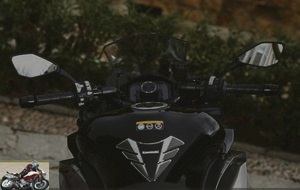 The large 19-liter tank promises a range of between 250 and 320 km depending on the pace of driving
The large 19-liter tank promises a range of between 250 and 320 km depending on the pace of driving
The little extra
According to some users, it seems that the radiator is exposed and a small hole can lead to 1000 euros of repair (700 euros for the factory radiator and 70 euros for protection). What not to hesitate to buy the radiator protection before.
Video test
Conclusion
Few motorcycles are as accomplished as this Kawasaki Ninja 1000 SX. Remarkable compromise between sport and road, the new opus further enhances the qualities of this model. Its four-cylinder always combines smoothness and explosiveness to best follow the versatile road pretensions of the machine. The finesse and performance of the electronic assistance systems clearly secure the evolutions while the agility of the chassis and an optimal riding position give a formidable efficiency to the Akashi machine.
Both its finishes, its comfort and its dynamic qualities make this sport-GT the benchmark of the genre. As the Russian poet Grigory Alaev says, "A car carries a body, a motorcycle carries a soul." An ode to road travel, the Kawasaki Ninja 1000 SX transcends travel, frees the mind. It is one of those machines whose qualities leave the pilot the only pleasure to ride, in all its forms..
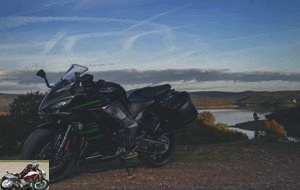 At its launch, the Kawasaki Ninja 1000 SX is displayed from 14,439 euros
At its launch, the Kawasaki Ninja 1000 SX is displayed from 14,439 euros
Its only opponent in the segment is the BMW R1250 RS, efficient road, but less sporty. Priced at € 15,350, excluding options, the German is more expensive with comparable equipment. And its tubular suitcase racks are always incomprehensibly unsightly ….
A dynamic traveler, the Kawasaki Ninja 1000 SX is aimed at bikers returning from too demanding and limited sports or from too cushy and cumbersome roads. The ideal compromise without any compromise, Akashi’s sport-GT is an essential benchmark.
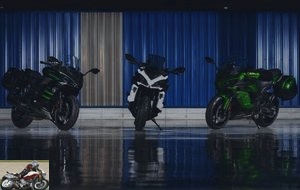 The three colors of the SX 2020 range
The three colors of the SX 2020 range
Strong points
- Aesthetic
- Equipments
- Engine character and availability
- Anti-dribble clutch
- Electronic
- Sportiness
- Sound
- Comfort and protection for the segment
Weak points
- No heated grips as standard
- Limited pilot recoil on the saddle
- Low value exhaust silencer
- Optional USB port
Kawasaki Ninja 1000 SX technical sheet
Test conditions
- Itinerary: winding and untied roads with variable surfaces
- Weather forecast: nice and cool
- Motorcycle mileage: 300 km
- Problem encountered: ras
Test equipment
- Nishua NTX2 Helmet
- Vanucci Tifoso jacket
- Jean Vanucci Armalith 2.0
- Glove Vanucci Speed Profi IV
- Vanucci VTB 20 Boots
Colors / price
- Metallic Graphite Gray / Metallic Diablo Black / green stripe (+ 200 €)
- Emerald Blazed Green / Metallic Carbon Gray / Metallic Graphite Gray
- Pearl Blizzard White / Metallic Carbon Gray / Metallic Spark Black
- Price: 14.349 €
- SE rate: 14.549 €
Standard equipment
- new 4.3 "color TFT display with Bluetooth connectivity
- reworked engine mapping, revised intake and camshaft (engine compliant with Euro5 standard)
- quickshifter up & down (disconnectable)
- ride-by-wire throttle control
- 4 engine modes
- new exhaust line
- more comfortable rider and passenger seats
- larger screen and adjustable in four positions
- speed regulator
- 100% LED lighting
- Modified fairing sides
- complete line of accessories
- uncluttered side cases anchoring points
- service interval set at 12,000 km and four-year warranty
- Original Bridgestone Battlax Hypersport S22
- Performance pack: 1450 €
- Tourer pack: 1350 €
- Performance Tourer Pack: € 2,700
Related articles
-
Honda Varadero 1000 XLV motorcycle test
Maxi-Trail with a road vocation The Honda XL 1000 V Varadero, which appeared in 1998, is the heir to the famous Africa Twin … but the manufacturer has…
-
Roadster with Sugomi sauce or decarenated sports car A2 licenses have the choice between large bridles, sometimes very badly bridled, and smaller ones,…
-
Kawasaki Versys 1000 SE motorcycle test
3rd evolution for the shock road trail hybrid 4 cylinders in line, 1,043 cm3, 120 hp and 102 Nm, KECS electronic suspensions, 257 kg, 16,899 euros…
-
Kawasaki Ninja ZX-10R KRT motorcycle test
An integer character 4 cylinders in line, 998 cm3, 203 hp, 114.9 Nm, 206 kg all full facts, 18,099 euros. Nice surprise for me to find the Kawasaki…
-
Without hesitation 4 cylinders in line, 165 hp, 114 Nm, 199 kg, Flex Frame, LED headlight, 14,980 euros The BMW S 1000 R is the roadster version of the…
-
Evolution or revolution of the ER6-f with the in-line twin of 649 cm3, 68 horsepower for 193 kilos A more sporty look but, paradoxically, a gain in…
-
Yamaha Tracer 9 and Tracer 9 GT motorcycle test
Cross-country sprinters 3 cylinders in line, 889 cm3, 119 hp and 93 Nm, 213 kg full made, from 11,499 euros Road trail, sport-touring, road … the names…
-
Authentic avant-garde 4 cylinders of 999 cm3, 152 hp, 106 Nm, 214 kg full made, 19 liter tank 45 years old ! The GSX saga began in 1976 with the GS 750,…
-
Kawasaki Versys 1000 S Grand tourer motorcycle test
Daily test for fifteen days 1,043 cm3, 120 hp at 9,000 rpm, 102 Nm at 7,500 rpm, 257 kg, 15,099 euros (17,099 euros Grand Tourer version) This bike, to…
-
Closely derived from competition, the Kawasaki KX 250 F and KX 450 F combine innovations and off-road performance. Struggling at the best level, they are…
To complete my comment above I can provide the chassis numbers concerned of course on request to confirm my comments.
Well, the lack of mastery of the thermal engine led HD to contact Benelli. For electricity, I advise you to wait for the technology transfer from Moulinex!
Great motorcycle indeed !
No saddle height problem with my 1m78,
the front of the saddle being quite narrow, you can tighten your legs to put your feet on the ground.
And very pretty, little known, she often surprises for the better.
"belly-saint-gris" as captain haddock would say but Damien what a great article with an astonishing lyricism in the world of motorcycles bravo
Well done 👏.
then you will say to me there is not only the lyricism but there is the content and then there also bravo bravo 👍👍 because it is super well licked with all the technical data that one expects from an excellent journalist . This article is to be shown in journalism schools.
now well done also to Aprilia for this magnificent very intelligent very powerful machine which in my opinion will be a hit especially at the price it is for sale.
Long live motorcycles on two wheels and long live Italy 💪 Forza Italia !!!
Houlah, that’s a lot of compliments and qualities for one man.
I don’t deserve so much.
Thanks for enjoying the trial.
"Disadvantage: No central stand as standard"
We are in the lair of the ‘old’ bikers ?
Sorry, reader friend, I fucked up with the + and –
not all correspond to this bike…
The +
Strong and elegant aesthetic
Engine character and availability
Orgiastic sound
Agility and efficiency of the chassis
Complete electronic assistance
Original equipment
Precise selection
Correct comfort
Quality of finishes
Overall dynamic efficiency
Pleasant instrumentation
Braking
The –
Improved quality of the rear shock absorber
A few injection spurts
Fragile paint